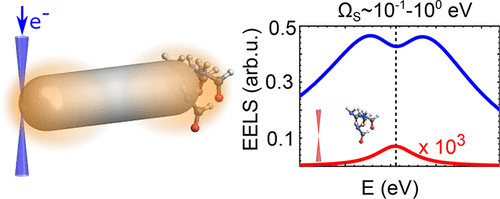Surface-Enhanced Molecular Electron Energy Loss Spectroscopy
Chemists have a range of different spectroscopic techniques to study organic molecules. All of these techniques are based on spectra generated by a range of electronic transitions and vibrations, key excitations in matter, the study of which provides information about characteristics of materials and, therefore, allow their identification.
In this context, one of those spectroscopic techniques is fluorescence, which provides information on the occupied and unoccupied molecular orbitals, as well as on the lifetime of the excited electronic states. On the other hand, the spectral information on molecular vibrations is typically accessed via the analysis of inelastically scattered light (Raman scattering), or from direct absorption of infrared light.
However, the direct interaction of light and matter, as used in these techniques, is often weak, and little or no signal can be obtained from small amounts of molecular samples. To overcome this limitation, metallic surfaces and nanostructures acting as efficient optical and infrared nanoantennas have been exploited to concentrate the electromagnetic field in the proximity of target molecules, thus producing a dramatic enhancement of their spectroscopic response.
These so-called surface-enhanced spectroscopy techniques rely on the electromagnetic near-field coupling of surface plasmons and matter excitations. For instance, surface-enhanced molecular fluorescence has revealed interference in single emitter’s fluorescence due to surface plasmon-exciton interaction; surface-enhanced Raman scattering has allowed to optically map the vibrational fingerprints of a single molecule in a plasmonic cavity; and surface-enhanced infrared absorption has provided vibrational information of a few thousands of molecules on metallic infrared nanoantennas.
Enter electron energy loss spectroscopy (EELS). In EELS a material is exposed to a beam of electrons with a known, narrow range of kinetic energies. Some of the electrons will undergo inelastic scattering, which means that they lose energy and have their paths slightly and randomly deflected. The amount of energy loss can be measured via an electron spectrometer and interpreted in terms of what caused the energy loss.

Now, a team of researchers from CFM, UPV/EHU, CIC nanoGUNE and DIPC propose 1 EELS in scanning transmission electron microscopy for studying the coupling between plasmons and molecular excitations (both electronic excitations and vibrations) with nanoscale spatial resolution. Interestingly, the researchers propose the use of plasmonic and infrared-phononic antennas to enhance EELS signals from optical excitonic and infrared vibrational excitations.
They coin the name “Surface-enhanced EELS” for this spectroscopic scheme, analogous to its optical counterpart. The interaction between plasmons in an optical antenna and molecular excitations can be so efficient that the “strong coupling regime” can be reached under certain circumstances.
In molecular fluorescence, for example, the strong coupling regime is reached when the interaction rate between the antenna plasmon and the molecular exciton is faster than the decay rate of both plasmon and exciton, leading to the creation of new hybrid plasmon-exciton polaritonic states. Thus, plasmon-exciton coupling offers intriguing possibilities to tailor molecular states for controlling of chemical reactivity or for quantum information processing.
Strong coupling phenomena have been studied by optically exciting plasmons and excitons. Recently, the concept of strong coupling has also been explored in the infrared spectral range, where the electromagnetic fields of phonon polaritons in hexagonal boron nitride (h-BN) antennas were coupled to infrared-active vibrations of molecules deposited on top of the antennas.
The reasearchers present a comprehensive numerical and analytical study of molecular excitations in STEM-EELS, which are enhanced by plasmonic and phononic nanorods, acting as effective nanoatennas. They first demonstrate the mechanism of antenna-molecule coupling probed by the electron beam in the visible spectral range. Then, provide details on the decay of the enhanced signal with the distance of the beam from the antennas. Finally, they demonstrate the possibility of using surface-enhanced EELS for (ultra-)remote molecular sensing, completing the set of advantages that the proposed technique offers.
Considering ongoing instrumental developments, EELS in STEM shows the potential to become a powerful tool for fundamental studies of molecules that are naturally or intentionally located on nanostructures supporting localized plasmon or phonon polaritons. Surface-enhanced EELS might also enable STEM-EELS applications such as remote sensing of the excitonic and vibrational response of molecules, quantum dots or 2D materials.
Author: César Tomé López is a science writer and the editor of Mapping Ignorance.
References
- Andrea Konečná, Tomáš Neuman, Javier Aizpurua, and Rainer Hillenbrand (2018) Surface-Enhanced Molecular Electron Energy Loss Spectroscopy ACS Nano doi: 10.1021/acsnano.8b01481 ↩